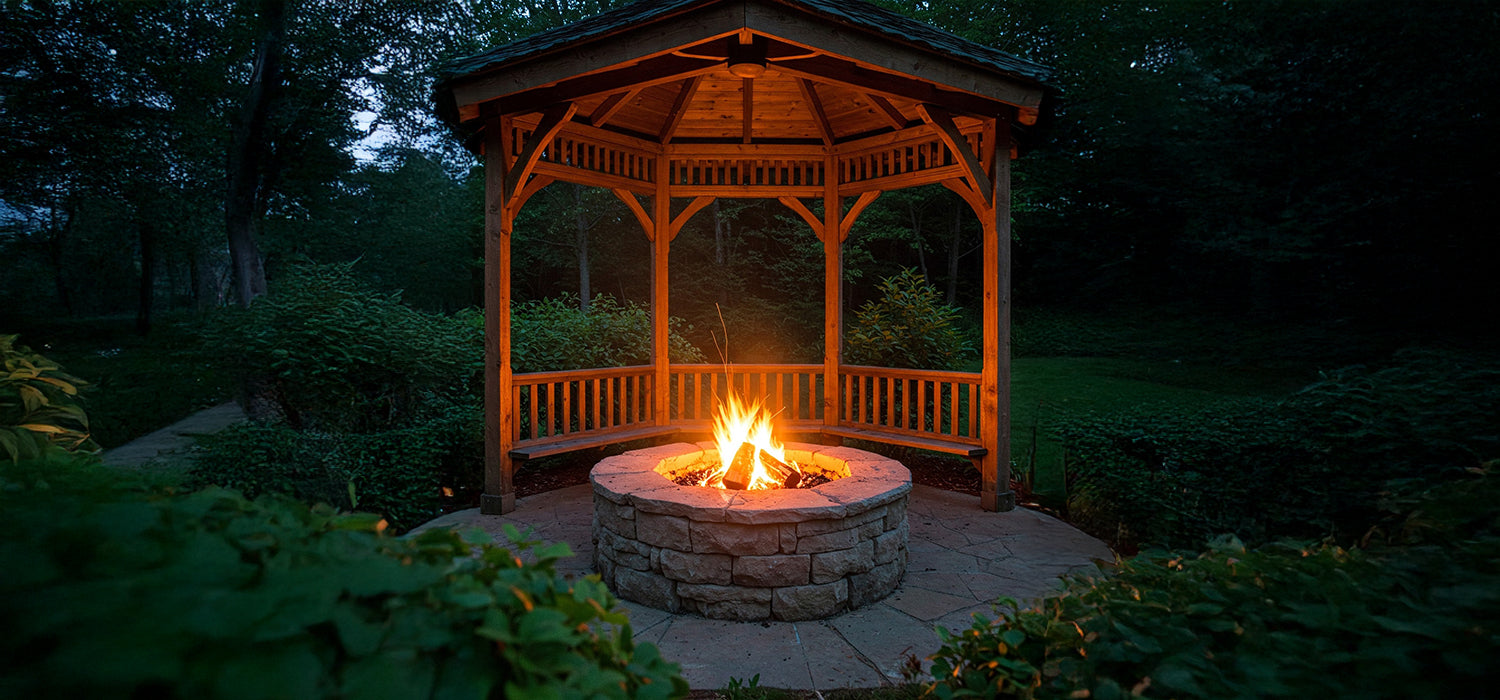
Can You Put a Gas Fire Pit Under a Gazebo?
Thinking of popping a gas fire pit under your gazebo? Short answer: yes—but only if you play by the safety rulebook! From ventilation hacks to fire-friendly materials (hello, fire tables!), we’ll cover all the sizzling do’s and don’ts to keep your backyard cosy and compliant.
Ventilation Requirements
Imagine settling in under your gazebo with a cuppa in one hand and a warm glow from the fire pit flickering nearby. Sounds lovely, doesn’t it? But before you light that flame, there’s one thing you must get right: ventilation.
Gas fire pits burn clean, but they still produce carbon monoxide. And when you trap that in a covered space, things can turn dangerous—fast.
Carbon Monoxide Risks
Potential for buildup in enclosed spaces
You can't see it, smell it, or taste it—but carbon monoxide (CO) can be deadly. Fire pits, even the neat gas-powered kind, release small amounts of this gas during combustion.
In an open garden, that’s no problem. But tuck a fire pit under a closed-off gazebo and suddenly, you're trapping CO where people breathe.
Think of it like running your car engine in a garage. Not a great plan.
Importance of adequate ventilation
That’s why ventilation is non-negotiable. Your gazebo needs to breathe. Open sides or louvred panels help air flow in and smoke drift out.
The more airflow, the safer you are. If your gazebo has walls on all sides, you might want to rethink your setup—or modify it with vents and gaps to keep the air moving.
Local Regulations and Building Codes
Requirements for gazebos and fire pits
Rules vary depending on where you live, but most councils have strict regulations about installing fire features.
That includes everything from the materials used in the gazebo’s structure to the size and type of fire pit allowed underneath. You’ll likely need a permit if you’re connecting to a gas line.
It’s always best to speak to your local authority or a qualified installer before cracking on.
Clearance and Safety Distances
Just because a fire pit fits under your gazebo doesn’t mean it should. Spacing matters more than you think.
No one wants scorched beams or a melted garden umbrella.
Distance from Ceiling and Walls
Maintaining a safe distance from combustible materials
You’ll want a gap of at least 8 feet between the top of your fire pit and your gazebo ceiling. That allows heat to rise and disperse safely.
If your gazebo is made from wood, fabric, or plastic—anything remotely flammable—then you need to be extra cautious.
It’s also smart to keep at least 3 feet of space around the fire pit on all sides. That means no hanging decorations, curtains, or stacked logs nearby.
Proper Airflow
Ensuring adequate ventilation
Even with enough vertical clearance, air still needs to flow through the space.
A covered gazebo with two or more open sides gives you that vital cross-ventilation. If your structure feels a bit enclosed, consider adding vents or removing panels to keep things airy.
Heat and gas should rise and escape—not hover awkwardly under the roof like an uninvited guest at a barbecue.
Fire Pit Design and Features
Not all fire pits are gazebo-friendly. Some pump out serious heat and flames, while others are designed to gently warm the space around you without turning your roof into toast.
Low-Profile Fire Pits
Reduced heat transfer to the ceiling
Enter: the fire table. These stylish, low-profile models are perfect for under-cover use (when properly ventilated).
They sit lower to the ground and produce a more controlled flame, reducing the heat that rises to your ceiling.
It’s a smart way to keep things cosy without risking a visit from the fire brigade.
Built-in Safety Features
Flame height adjustment and safety shut-off
Look for models with adjustable flame controls and automatic shut-off valves. These features aren’t just for peace of mind—they’re often a legal requirement.
A fire pit that lets you turn the flame down or off quickly can make all the difference when there’s a sudden gust of wind or a curious pet nearby.
Bonus tip? Some fire tables even come with glass surrounds to help shield the flame from breezes.
Alternatives and Precautions
If the thought of open flames under your gazebo still has you feeling uneasy, there are other ways to enjoy the warmth.
Let’s look at a couple of smart workarounds.
Open-Air Areas
Safer option with better ventilation
Sometimes the safest move is to take the fire pit just outside the gazebo.
That way, you can enjoy the view, stay warm, and keep ventilation worries at bay. Add some comfy chairs and maybe a weatherproof rug, and voilà—you’ve got yourself an outdoor lounge.
This setup also gives you more flexibility in fire pit styles and sizes.
Carbon Monoxide Detectors
Using detectors for added safety
Want to go the extra mile? Pop a portable carbon monoxide detector in your gazebo area.
These clever little devices are battery-operated and built for outdoor use. They’ll give you an early warning if CO levels start to creep up, even in semi-open spaces.
It’s a small investment that could save lives—definitely worth it.
Conclusion
So, can you safely put a gas fire pit under a gazebo? Absolutely—as long as you do it properly.
That means making sure your gazebo is well-ventilated, giving your fire pit plenty of breathing space, and sticking to safety-first designs like fire tables with built-in shut-offs.
Always check local regulations, and if in doubt, bring in a professional to guide the setup.
With the right planning, you’ll have a stylish, warm, and safe outdoor retreat—perfect for chilly evenings, garden gatherings, and a cheeky glass of wine around the fire.
Other content we think you'll love
- Is it Safe to Put a Fire Table on Wooden Decking?
- Is It Safe to Put a Fire Table on Composite Decking?
- Can Fire Tables Be Placed on Grass?
- Can You Put a Fire Pit on Fake Grass?
- Will Fire Pit Kill Grass?
- Can You Use a Gas Fire Table Under a Covered Patio?
- Can You Put a Gas Fire Pit Under a Pergola?
- Can You Put a Gas Fire Pit on a Deck?
- The Ultimate Guide to Fire Pits Under Awnings: Safety, Design, and More
- Can You Put a Gas Fire Pit in a Wood Table?
- Is a Gas Fire Pit Considered an Open Fire?
- Can I Have a Fire Pit on My Balcony?
- Fire Pit Under Polycarbonate Roof: Everything You Need to Know

